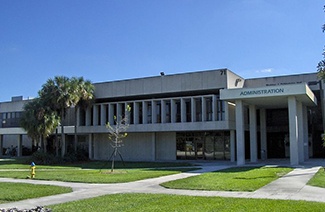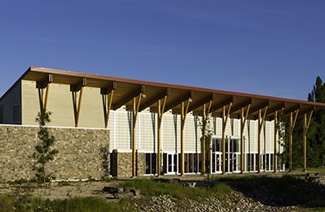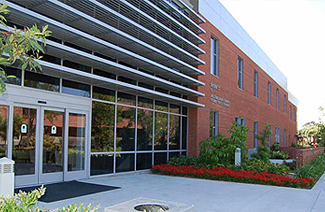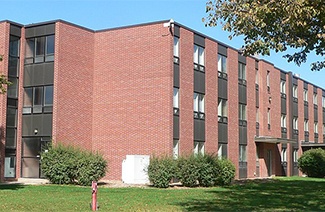Narrator
Listen to part of a lecture in a biology class.
Professor
So today we’re gonna talk about song development in birds and how — you may be surprised to know — the songs of most songbird species are learned — not completely instinctual — which is what we used to think…so I’d like to start things off today by, um, centering our discussion on the chaffinch.
The chaffinch is a type of European songbird, and we’re gonna use the chaffinch’s song development as illustrative of songbirds’ song development in general, because many other songbirds follow this same pattern, this pattern of learning songs.
Okay, so soon after hatching, baby chaffinches just start producing these, um, begging sounds, begging calls, actually, which basically are a message to the parents saying, “Feed me; feed me.” That’s all for about the first five weeks, until they grow feathers and start getting ready to fly, you know, become fledglings, and then those calls — those begging sounds — are replaced by, uh, well…you know how babies — human babies — you know how they make that…baby…babbling sound? Like little, soft, vocalized… murmurings? Well, that’s pretty much similar to the noises that fledgling chaffinches make at this next stage of development…which is called subsong…
“Subsong” makes sense, right, because “sub” means “below,” and so the subsong is…uh, below, or…happens before their mature song, right? It’s an immature or underdeveloped song, a baby song. Make sense?
笔记区:
Okay, now, they’re not begging for food anymore with the subsong. So what do you figure they’re making these soft murmurings for? Well, it’s at this stage — what we call early subsong — that, and this is important, the chaffinch’s subsong begins to provide auditory feedback from which the chaffinch learns, and so...self-learning is taking place, because the fledgling hears itself calling out, hears the sounds it’s making, you know, hears, hears its subsong, and so, it’s kinda’ comparing it to the parent’s song and so self-learning is taking place, um, through this process…get it?…
Alright. Now, as the chaffinch gets a little older, it enters into what could be called late subsong where parts of its subsong start sounding more and more like its parent’s song,
and we have the next step in song development taking place in late subsong, that is, the introduction of plastic song within the subsong — plastic song referring to — I don’t have to write that on the board, do I? — referring to the parts of the subsong that sound like the parent’s song.
Plastic song. Does that sound a little strange to you? Well, keep in mind that “plastic” has, um, formative implications, you know, it can mean, like, growth, or development into something
…like what the chaffinch’s song is doing…it’s developing into its parent’s song…it’s, uh, not quite fully realized yet—it doesn’t sound precisely like its parent’s song — remember this is still the subsong stage we’re talking about — but it’s on its way, the fledgling is still learning, imitating parts of its parent’s song, just not quite the whole thing yet.
So. The fledgling gets older and now it’s winter, and during the winter, the young chaffinch doesn’t practice its singing. But in the spring, the chaffinch starts back up again, singing and practicing, and this time there is more of an emergence of plastic song, ah…a stronger presence of it within the subsong, and so thereby, the parent’s song is growing increasingly more recognizable and distinct, follow? Then, after about a month, the young chaffinch’s song crystallizes into what’s called full song — the, um, exact song the adults sing. So full song’s, uh, a full-blown imitation of the adult song. Alright?
Now what’s interesting is that chaffinches are able to complete this process, even from only a short exposure to their parents’ song. Exposure during the first few weeks of life is really all they need, and after that they can remember it, even though they need quite a bit of practice to produce it accurately themselves. So the theory is that there is a sensitive period in the chaffinch’s early life, its early development, a special sensitive period during which it learns what its song should sound like. So chaffinches, um, along with many other birds, learn songs early in life, and when they become adults,
they don’t change their songs—it’s a copy of the parents’ song, like we said, okay?
Narrator
Now get ready to answer the questions. You may use your notes to help you answer.
1. What aspect of a chaffinch’s song does the professor mainly discuss?
(A)How it is used to beg for food
(B)How it has changed over several generations
(C)How its development differs from that of other songbirds
(D)How it develops from an early age
2. How does the professor introduce her description of the sounds a chaffinch makes during subsong?
(A)She contrasts the subsong of a chaffinch with the subsongs of other songbird species.
(B)She compares the sounds a chaffinch makes to those a human baby makes.
(C)She describes the sound of an adult chaffinch’s full song.
(D)She reminds the class how scientists define begging calls.
3. What does the professor say about plastic song?
(A)It imitates only parts of the parent’s song.
(B)It is identical to subsong.
(C)It is instinctual and does not need to be learned.
(D)It represents the final stage in a chaffinch’s song development.
4. What is the evidence for chaffinches’ having a sensitive period for song learning?
(A)They begin to practice their song in the spring.
(B)They do not develop full song until their second year.
(C)They need little exposure to adult song in order to learn it.
(D)They do not make many sounds for the first five weeks of their lives.
Narrator
Listen again to part of the lecture. Then answer the question.
Professor
--and we have the next step in song development taking place in late subsong, that is, the introduction of plastic song within the subsong--plastic song
referring to--I don’t have to write that on the board, do I?
5. What does the professor imply when she says this:
Professor
I don’t have to write that on the board, do I?
(A)The words in the term are probably familiar to the students.
(B)The term is not important to the lecture.
(C)The students should have studied the term already.
(D)The students should have written the term down already.
6. Why does the professor say this:
Professor
Plastic song. Does that sound a little strange to you? Well, keep in mind that “plastic” has, um, formative implications, you know, it can mean, like, growth, or development into something
(A)To correct something she said earlier
(B)To explain a term she just introduced
(C)To explain what is wrong with a particular theory
(D)To remind the students of something discussed earlier
Narrator
Listen to part of a lecture in a business class.
Professor
OK, uh let’s um, let’s start. Uh, tonight we’re gonna talk about one approach to structuring decision-making on a specific topic, sort of um…oh when you’re in a decision-making process in a business situation, and you’ve got all the participants there sort of voicing opinions and negotiating, and there are lots of different factors to consider in your decision…uh, the technique we’re gonna talk about is uh, it’s a way to sort of structure that decision and arrive at a better decision. It’s called AHP, or Analytic, um, Analytic Hierarchy Process.
Now, the first step is to develop, a hierarchy by breaking the problem down into its components, and then prioritizing the components, as you’ll see.
Now there’s some AHP software out there that lets you do the math, but I’m not gonna get into that level of detail now. The important thing that I want to talk about is not the mathematics of it so much as the concept.
I, I want you to understand the logic behind Analytic Hierarchy Process and the basic approach.
OK…so uh, let’s say, if I was trying to buy a house, a house is actually a pretty good example. It’s not a good example for a business class, necessarily, but it’ll certainly do for today.
You, you start with your main goal. An’ then you break it down into smaller parts. All right…so uh, taking our example of, of buying a house…I would have to determine the goal for the house-hunting effort, uh choose the house that would be uh,…most, well, the best fit for my family. What would be your goal in trying to find a house? Well, uh let’s just say, make the best choice in, in buying a new house. Now, now that’s the goal.
So now that you’ve established a goal, you establish your criteria. And um, under criteria I would list for me what were the important factors that will influence the decision. And…they would be things like uh, like the cost. And, uh what else? Uh, location. Location, I think, would typically be one in most of our models, and maybe one more. How about floor plan?—The layout of the rooms. So, so we have cost, location, floor plan…those might be our key criteria for choosing a house.
Then you get down to the subcriteria under each of these three criteria. So, so let’s say, under floor plan, the subcriteria are, you want a big kitchen, 3 bedrooms, a basement. And after you’ve determined all the criteria and subcriteria, um then you go back and you start making pairwise comparisons between them…uh,
笔记区:
judgments about two of these things at a time.
Of the houses you’re considering, uh, is cost more important than location or, say, one has a big kitchen but only two bedrooms. Is that OK?
You move through the hierarchy making judgments about 1 pair of choices at a time. You see, it, it it’s designed to reflect the way people actually think…humans are much more,…capable of making relative rather than absolute judgments. Basically, we’ve reduced a rather complex decision into a series of one-on-one comparisons.
Um, so what AHP does is it requires me to develop a schematic model of what I’m looking for. So, so, right off the bat I have to articulate and think about and identify these factors, these criteria.
And when I start comparing the criteria, these factors, um, it enables me to come up with the relative importance of each factor at a given level in the model. So, in other words, what the model does is it helps us set our priorities, and it forces us to make our priorities explicit. It, it not, not only helps make the best decision, we’re also a lot clearer on why we made the decision. And understanding why we made the decision makes it easier to convince the boss or the shareholders that it’s a good decision.

















